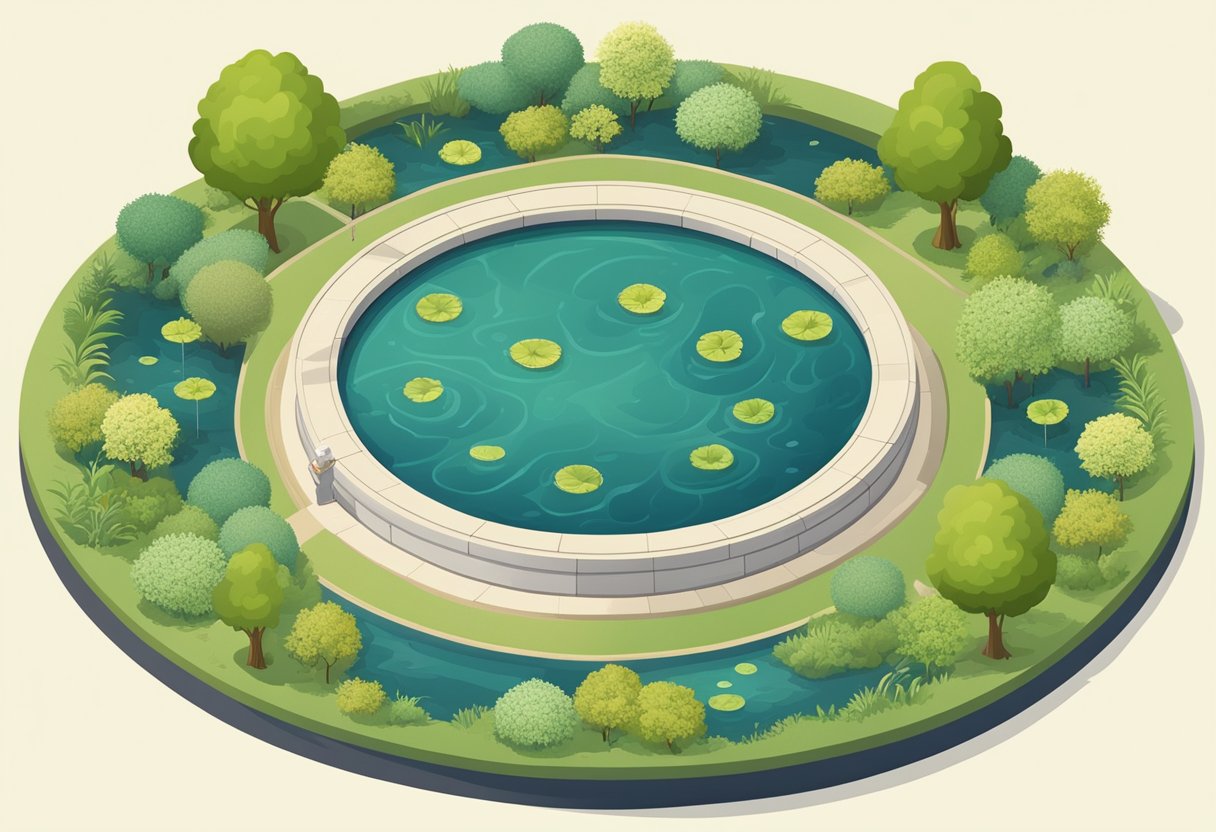Koi ponds are a beautiful addition to any backyard, providing a serene and peaceful atmosphere. However, finding the perfect location for your koi pond can be a challenging task, especially when you’re on a budget. There are several factors to consider, such as the amount of sunlight and shade, proximity to trees, and the overall layout of your yard.
One of the most critical factors to consider when selecting a location for your koi pond is the amount of sunlight and shade. Koi require a balance of both to thrive, so it’s essential to find an area that provides shade during the hottest parts of the day. Additionally, you’ll want to avoid placing your pond under trees, as falling leaves and debris can make maintenance a challenge.
Another factor to consider when selecting a location for your koi pond is the overall layout of your yard. You’ll want to choose a spot that complements the existing landscaping and doesn’t look out of place. Additionally, you’ll want to ensure that the pond is visible from your home, so you can enjoy it even when you’re not outside. By taking these factors into account, you can find the perfect location for your koi pond without breaking the bank.
Understanding Koi Pond Basics

Pond Size and Depth
When it comes to building a koi pond, size and depth are important factors to consider. Koi fish can grow up to 3 feet in length, so a pond that is too small can lead to overcrowding and poor water quality. A good rule of thumb is to have at least 1000 gallons of water for every 3-4 koi fish.
In addition to size, the depth of the pond is also crucial. Koi fish need a minimum depth of 3 feet to swim comfortably and avoid predators. However, a depth of 5-6 feet is recommended to provide better water quality and temperature regulation.
Water Circulation and Filtration
Proper water circulation and filtration are essential for maintaining a healthy koi pond. Water should be circulated at least once every hour to prevent stagnant areas and promote oxygenation. A good filtration system is also necessary to remove debris, excess nutrients, and harmful bacteria from the water.
There are several types of filtration systems available, including mechanical, biological, and chemical filters. Mechanical filters remove large debris, while biological filters use beneficial bacteria to break down harmful substances. Chemical filters can be used to remove specific contaminants, such as ammonia or chlorine.
It is important to choose a filtration system that is appropriate for the size of the pond and the number of fish. A well-designed filtration system will help keep the water clear and healthy for your koi fish.
Evaluating Your Budget

When planning a koi pond on a budget, it’s important to evaluate your financial resources and determine how much you can afford to spend. This will help you make informed decisions about the size, materials, and installation options for your pond.
Cost-Efficient Materials
One way to save money on your koi pond is to choose cost-efficient materials. For example, instead of using expensive natural stone for the pond’s border, consider using concrete pavers or bricks. These materials are durable, easy to install, and significantly less expensive than natural stone.
Another cost-efficient option is to use a pre-formed pond liner instead of building a pond from scratch. Pre-formed liners are available in a variety of sizes and shapes, and they can be a great way to save money on excavation and construction costs.
DIY vs. Professional Installation
Another factor to consider when evaluating your budget is whether to install the pond yourself or hire a professional. While DIY installation can save you money on labor costs, it’s important to have the necessary skills and equipment to ensure that the pond is installed properly.
If you’re not confident in your DIY abilities, it may be worth investing in professional installation. While this option is more expensive, it can save you money in the long run by ensuring that the pond is built to last and minimizing the risk of costly mistakes.
By evaluating your budget and exploring cost-efficient materials and installation options, you can create a beautiful and functional koi pond without breaking the bank.
Selecting the Ideal Location
When it comes to selecting the ideal location for your koi pond, there are a few factors that you should consider to ensure the health and happiness of your fish. Here are some key considerations to keep in mind:
Sunlight and Shade Balance
Koi fish thrive in a well-balanced environment, and the amount of sunlight and shade your pond receives plays a major role in this. Too much direct sunlight can lead to overheating and an overgrowth of algae, while too much shade can limit the growth of plants and reduce the amount of oxygen in the water. It’s important to find a location that strikes a balance between the two.
Proximity to Trees and Plants
Trees and plants can provide shade and shelter for your koi, but they can also pose a risk if they drop leaves or branches into the pond. When selecting a location, consider the proximity of any nearby trees or plants and whether they pose a risk to the health of your fish.
Ground Stability and Terrain
The stability of the ground and the terrain of the location are also important factors to consider. A pond that is built on unstable ground can shift and crack over time, causing damage to the pond and potentially harming your fish. Additionally, a location with a steep slope or uneven terrain can make it difficult to properly install and maintain your pond.
By taking these factors into consideration, you can select the ideal location for your koi pond that will provide a healthy and happy environment for your fish without breaking the bank.
Designing Your Koi Pond
When designing a koi pond, there are several factors to consider. A well-designed koi pond not only provides a healthy environment for the fish, but also enhances the beauty of the surrounding landscape. Here are some aesthetic considerations to keep in mind:
Aesthetic Considerations
- Size: The size of your koi pond will depend on the number and size of koi you plan to keep. A pond that is too small can limit the growth and health of your fish, while a pond that is too large can be difficult to maintain and may look out of place in your yard.
- Shape: The shape of your koi pond can be either formal or informal. Formal ponds are usually geometric in shape, with straight lines and right angles. Informal ponds, on the other hand, have a more naturalistic look, with curved lines and irregular shapes.
- Depth: Koi ponds should be at least 3 feet deep to provide a safe and healthy environment for the fish. Deeper ponds can help regulate water temperature and reduce the risk of predators.
- Materials: There are a variety of materials to choose from when building a koi pond, including concrete, fiberglass, and preformed liners. Each material has its own advantages and disadvantages, so it’s important to do your research and choose the one that best suits your needs and budget.
Incorporating Natural Elements
In addition to the aesthetic considerations, incorporating natural elements into your koi pond can help create a more harmonious and relaxing environment. Here are some ideas to consider:
- Waterfalls: A waterfall can add a soothing sound and visual element to your pond. It also helps oxygenate the water and provides a natural filtration system.
- Rocks and boulders: Adding rocks and boulders to your pond can create a more naturalistic look and provide hiding places for your fish.
- Plants: Aquatic plants not only add visual interest to your pond, but also help oxygenate the water and provide shade for your fish. Some popular choices include water lilies, lotus, and water hyacinths.
By taking these factors into consideration, you can design a beautiful and functional koi pond that fits your budget.
Maintaining Your Koi Pond
Regular Cleaning Schedule
Keeping a regular cleaning schedule is essential for maintaining a healthy and thriving koi pond. The frequency of cleaning will depend on the size of your pond, the number of fish, and the filtration system you have in place. As a general rule, it is recommended to clean your pond every two weeks during the summer months, and once a month during the winter.
Here are some steps to follow when cleaning your koi pond:
- Remove any debris, such as leaves or twigs, from the surface of the water using a net.
- Use a pond vacuum to remove any debris from the bottom of the pond.
- Test the water quality and adjust the pH, ammonia, and nitrite levels as needed.
- Top up the water level if necessary.
- Clean the filters and replace any filter media that is worn or dirty.
- Check the equipment, such as pumps and aerators, to ensure they are functioning properly.
Seasonal Care and Maintenance
In addition to regular cleaning, there are some seasonal tasks that should be performed to keep your koi pond in top condition. Here are some tips for seasonal care and maintenance:
Spring
- Perform a thorough cleaning of the pond, including removing any accumulated debris and sludge.
- Test the water quality and adjust the pH, ammonia, and nitrite levels as needed.
- Check the equipment and replace any worn or damaged parts.
- Add beneficial bacteria to the pond to jumpstart the biological filtration process.
Summer
- Monitor the water temperature and make adjustments as needed to keep it within the optimal range for koi (around 75-80°F).
- Keep the water level consistent by topping up as needed.
- Check the filters and clean or replace them if necessary.
- Add beneficial bacteria to the pond to maintain a healthy biological balance.
Fall
- Remove any fallen leaves or other debris from the pond to prevent them from decomposing and affecting water quality.
- Test the water quality and adjust the pH, ammonia, and nitrite levels as needed.
- Reduce the amount of food you are feeding your fish as they will begin to slow down and eat less as the water temperature drops.
- Check the equipment and make any necessary repairs or replacements before winter.
Winter
- Stop feeding your fish once the water temperature drops below 50°F.
- Remove any excess debris from the pond to prevent it from decomposing and affecting water quality.
- Reduce the water level to prevent freezing and damage to the pond and equipment.
- Check the equipment and make any necessary repairs or replacements before spring.
By following these regular and seasonal care tips, you can maintain a healthy and thriving koi pond on a budget.
Final Words
Finding the best place for your Koi pond on a budget can be challenging, but it is not impossible. By considering factors such as location, size, and materials, you can create a beautiful and functional pond that fits your budget.
Remember to do your research and shop around for the best deals on materials and equipment. Consider using recycled materials or repurposing items you already have to save money. Don’t forget to factor in ongoing maintenance costs when budgeting for your pond.
Overall, building a Koi pond on a budget requires careful planning and consideration. With the right approach, you can create a stunning and affordable water feature that will bring joy and relaxation to your outdoor space.

As a dedicated veterinarian and animal enthusiast, I, Phoebe Wright, bring a unique perspective to my writing about Koi Fish. With my expertise in animal care, I strive to share valuable insights in a friendly and approachable manner, making my posts both informative and enjoyable to read.







